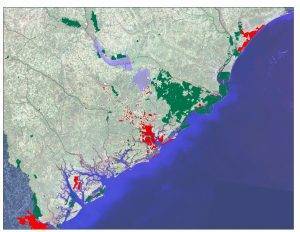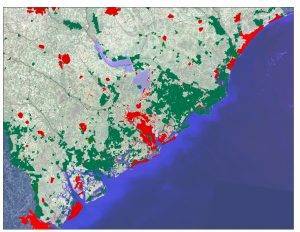Project
Support Charleston County’s Greenbelt Program
In 2004 and again in 2016, Charleston County voters passed the half-cent sales tax, which primarily funded roads, but importantly set aside $221 million to create “greenbelts” across the county through land protection.
Citizens were rightfully concerned that new roads funded through the sales tax would mean new development and growth that, if left unchecked, would destroy the rural character and sensitive natural landscapes that define Charleston County.
Charleston County Council appointed a 14-member Greenbelt Advisory Board to craft a plan on how Greenbelt funds were to be spent. After 10 months of gathering extensive public input, conducting a greenspace inventory, and determining the future greenspace needs of the County, the Comprehensive Greenbelt Plan was finalized and approved unanimously by County Council in June 2006 and then incorporated into the County’s Comprehensive Land Use Plan in January 2007.
Land conservation is a complementary tool for planning and zoning decisions. Protecting land encourages rural land uses like farming and supports open space along rivers and marshes. In fact, since 2004 the Greenbelt program has protected 7,000 acres of working farm and timberlands. Land conservation in strategic areas also reduces future traffic challenges by reducing development potential in rural areas that cannot support intense development and the associated infrastructure without compromising both natural resources and quality of life.
To date, the Charleston County Greenbelt Program has:
- Protected an additional 21,000 acres of Charleston County’s most vulnerable properties. Combined with the 17,000 acres protected by conservation partners and 160,000 acres that were already protected, roughly 30% of Charleston County lands have been conserved in perpetuity.
- Made our communities healthier. We all enjoy health and recreation benefits from being outdoors. Our ability to be outside, walk, run and enjoy the outdoors saves county residents money on their medical bills and lowers the cost of healthcare shouldered by taxpayers.
- Kept local farmers on their land, providing us all with better food. The 2012 Census of Agriculture showed three hundred fifty-nine farms in Charleston County generating $25 million in agriculture product value. These farms, either protected themselves or supported by a rural landscape of protected properties, provide fresh food for our community and South Carolina, and support a thriving local restaurant community.
WHY PROTECT LAND?
Our region is defined by our bustling urban harbor, winding creeks and saltmarshes, healthy fisheries, rural farm and timberlands and thriving small communities.
- Approximately 67% of Charleston County is in a FEMA flood hazard area. Protected land, with or without public access, acts as a sponge to absorb floodwater and filter runoff, reducing the need for expensive stormwater infrastructure and protecting surrounding water quality.
- Our state’s fisheries and ocean-based tourism and recreation support nearly 79,000 jobs and generate over $4.4 billion in GDP each year in South Carolina.
Our region is also defined by fast-paced growth and development, popular beaches and tourist attractions.
- In 2017, 6.9 million visitors came to Charleston County, and tourism generated $7.37 billion in economic impact.
- Charleston County is growing at 3 times the national average, and roughly 38 people move to the tri-county region (Charleston, Berkeley and Dorchester) each day.
- The Census Bureau estimates Charleston County gained 4,868 residents in 2017. Previously, the county averaged nearly 7,600 additional residents each year since 2010.
To maintain balance between our natural resources, economic growth and quality of life, we must continue to invest in land protection throughout the region.
WHAT IS A CONSERVATION EASEMENT?
Easements involve working with a willing landowner, who retains ownership of the land but is compensated for reducing or eliminating the development rights on the property. Conservation easements are often cheaper than buying the land and keep the land on the county tax rolls. We believe the program should continue to prioritize easements over outright acquisition in the rural areas.
LAND CONSERVATION ACROSS SOUTH CAROLINA
Since 1985, more than 1.2 million acres have been protected on the South Carolina coast. The healthy coastal greenbelt contains and enhances our growing community and provides recreational opportunities, clean water and an unparalleled quality of life. See maps below.
Recently, the Charleston County Greenbelt Advisory Board recommended a change in allocation that shifted $40 million from funding for rural land protection to urban projects. County Council approved changing the allocation from 70% rural/30% urban to an even 50/50 split on a vote of 5-4. With less money for rural land protection to harden the urban growth boundary and prevent sprawl, it is more important than ever to ensure projects in both the urban and rural areas are impactful, well-leveraged and provide multiple long-term benefits to our region.


